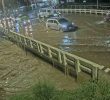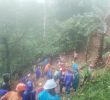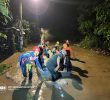
The housing project in Brgy. Poblacion, Baganga, Davao Oriental. (photo contributed by Juland Suazo)
by JOHN RIZLE L. SALIGUMBA
Davao Today
CATEEL, Davao Oriental – Normelinda Masumbid and her neighbors waited in anticipation of owning units in a housing subdivision being constructed across the street.
The houses, painted yellow, were supposed to be given to Typhoon Pablo survivors like them last December 4 by the provincial local government.
Governor Corazon Malanyaon, however, dashed Normelinda’s hopes when the governor said they had to postpone the turnover of the houses because President Benigno Aquino III, “had other important things to attend to.”
“Let us wait for him as the President still signified intention to attend,” Malanyaon added.
Normelinda’s town, Cateel, was one of the towns heavily battered by Typhoon Pablo destroying farms and houses.
For a year, Normelinda and her neighbors have been living in a makeshift house they built with galvanized roofs donated by the Philippine Red Cross and tarpaulins as walls which they got from aid groups.
Before the storm, her family relied on a coconut farm in Barangay Aliwagwag that her husband tended to.
But the storm uprooted all the trees. Now her husband drives a trisikad at the town proper, while Normelinda sells plastic wares and beauty products.
Like Normelinda, thousands of other families in Cateel, Boston and Baganga towns have been living in temporary shelters such as ‘bunkhouses’ built by the government or in ‘shelter tents’ donated by aid groups.
In its statement during the first year commemoration of Typhoon Pablo, the National Democratic Front Southern Mindanao slammed the housing projects of the government for concentrating it in town centers while abandoning farms where houses of farmers should have been built.
“The US-Aquino regime marshaled and concentrated its limited resources in the province, town and selected village centers as they abandoned far-flung farms communities and forests—areas that they declared as geo-hazardous for habitation,” Rubi del Mundo, NDF spokesperson said.
The NDF pointed out that “it was a strategy meant to dislocate peasants and Lumads in their lands and concentrate them to areas where the military and GPH can easily control them.”
The NDF added that “The hamletting served the dual purpose of controlling movement of villagers while leaving forests and farms easily accessible for large-scale mining and capitalist incursion.”
Meanwhile, Provincial Social Welfare and Development officer Gemma dela Cruz said the province has already constructed 641 houses, but they still have to reach the target of providing houses for 24,000 families.
Victor Serdan, a worker from Barangay Kinablangan of Baganga town, opted to stay in a remote island of Poo.
But the provincial government has declared Poo a “no-build zone” and even questioned the construction of a new building without coordinating with them. Now residents asked where will they go.
Settlers there said they have not heard of relocation sites, housing projects or surveys for that matter.
Some residents have been living in a ‘bunkhouse’, and wanted to stay.
“Those who opted to stay in the island just ask to be warned of danger so that they could vacate ahead towards safe areas as they really have no choice but to live there,” a resident said.
Governor Malanyaon appealed for residents to wait because funds for the housing projects were already “downloaded” to the provincial government.
Normelinda said still has received no word when she will get her house.
“They already built about 72 but only 14 have been fully painted. They say more than 300 houses will be built here and we are one of the beneficiaries. We have been interviewed and surveyed many times already,” she noted.
“It would also be good if they already gave us the titles or any paper to prove that we own the house because as of now we really don’t know if it’s true,” Normelinda said
She said her time could have been better spent looking for work rather than waiting for the house to be finished. (John Rizle L. Saligumba, davaotoday.com)
davao oriental, Rehabilitation in Typhoon Pablo areas, typhoon Pablo, workers









